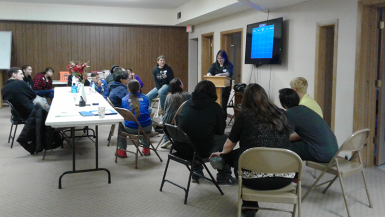Not long after his time at IAIA, Donald sought out a mentoring relationship with fellow Native artist Herman Red Elk, which helped him hone his own artistic style. The elegant, long-legged horses that are a signature of Donald’s work are actually inspired by a story Herman shared with Donald many years ago.
“One day Herman and I were sitting, talking, having a smoke, and he was telling me a story. He said that when the Lakota were attacked, they always looked for a rise in the landscape that they could come off of, and they always had a pouch underneath their horse’s mouth. Inside that pouch were herbs and spices, and it gave the horse a burst of energy,” he said. “When they came off that hill into battle, they jerked that pouch into the horse’s mouth and the horse would ‘fly down the hill’. As soon as Herman said ‘fly down the hill,’my horses never loped or galloped again. My horses fly. That’s why their legs are elongated.”
Not wanting to compete with Herman, who was a renowned buffalo hide painter, Donald gravitated towards using ledger paper for his art. Native art on ledger paper is a tradition derived from a period in the 19th-century when the buffalo population in the plains plummeted due to the encroachment of European settlers and government-paid hunters who slaughtered the buffalo as trophies. With a lack of hides available as canvas for tribal artwork, Native Americans would barter with traders and soldiers for pages of used ledger books in exchange for other goods. At that time, the Lakota still did not have a written language, and so the artwork created on these pages served as a way to preserve history.
“We saved our culture through these old books and these drawings on the pages. They showed that family their history. How their grandfather used to dress on his war horse, how his war horse was painted and designed, what he carried into battle. If he carried a bow or a lance, what society he was in, what he could wear in his hair, what headdress, or feather,” he explained. “That’s what we used to put on hides, and that art carried over into ledger books.”
The ledger art that Donald creates today serves not only as a means of preserving images of traditional Lakota life, but also of educating art lovers and art collectors about the Northern Plains tribal culture. He credits art shows as an important means of spreading awareness about the unique styles of art produced in the Northern Plains, as well as a way for artists to gain access to both financial support and feedback.
“Every time you sell a piece, when you’re younger and just starting out, you’re just blown away,” he said. “As you grow and mature, selling a piece really motivates you to do another one. It really gives you confidence that there’s someone out there that likes your work. Then as you develop, you learn that they might buy my artwork because they like it, but they are also buying me, because I’m the individual who is going to be creating more. And as my reputation grows, so does the work that’s on their walls. It grows in price because of who I am as an artist.”
Source link




